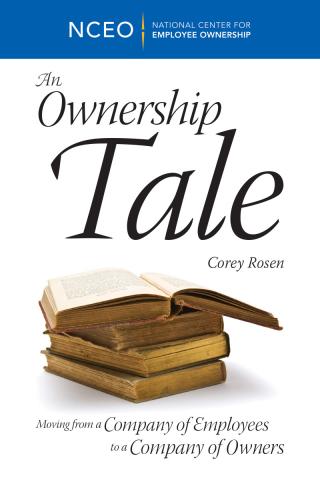Description
An Ownership Tale is the story of a fictional company, BTA Associates, and how it moved from having an ineffective ESOP to an engaged ownership culture. What happens in the book is based on NCEO director Corey Rosen's 30 years of working in this field. The barriers, stumbles, conversations, first steps, and final resolutions are all based on the real experiences of companies and their employee owners.
This 65-page book is meant to be accessible to every employee in your company. You might choose to buy it just for management or an ESOP committee; others will buy a copy for everyone. The book contains specific ideas you can put to work in your company, not just generalities about the need for better trust or communications. It also includes a set of group exercises to help implement the ideas.
In short, this book is an essential tool for creating an ownership culture.
"An Ownership Tale is more than just a story about business. It is a story about individuals who figure out that by working for the success of one another you can create a special place where people know that they can make a difference."
—Jack Stack, President & CEO, SRC Holdings Corp.
"An Ownership Tale shifted my perspective. All the emotions, all the doubts, all the frustrations and thankfully, all the suggestions are spot on. We just kicked off Q4 and we created plans for committees, shifted compensation, revamped financial communication, and created plans for providing training for all employees (including myself) on how to read income statements. We had an ESOP but did not have an ownership culture. I have always believed in an empowered culture, so the shift to an ownership culture is a natural and painless progression."
—Eric French, Internal Data Resources, Inc.
Product Details
Table of Contents
Preface
Chapter 1: In the Beginning
Chapter 2: A Bump-Make That a Big Pothole-In the Road
Chapter 3: Open Doors, Empty Doorways
Chapter 4: Getting the Message Across
Chapter 5: Leaps of Faith
Chapter 6: The Numbers Game
Chapter 7: From Open Doors to Open Book
Chapter 8: Making Progress
Chapter 9: Setting Up a System of Involvement
Chapter 10: Incentive Plans and Other Missteps
Conclusion
Appendix A: Ownership Culture Resources
Appendix B: A Subject Guide to An Ownership Tale
Excerpts
From Chapter 3, "Open Doors, Empty Doorways"
Bob went back to his office feeling pretty proud of himself. What he did was not easy for him. He'd spent years under Mary and Sam's tutelage. They had been generous but very traditional owners. Employees were paid well and got good benefits, but Sam and Mary made just about every decision that mattered, working long, long hours to do so. Bob had assumed he would take over their role in much the same way. After all, Sam and Mary hired him out of a competitor company because he was, they said, a decisive, smart, take-charge kind of guy. Bob had figured the ESOP would be just another benefit and that employees would be grateful for the chance both to own stock and keep their jobs.
But now that did not seem enough. For years, Bob, Kevin, and Rosario had been urging people to think and act like owners, but they never really thought through just how that would play out in day-to-day work. Now Bob thought he had really taken the leap. If employees wanted to act like owners, he had laid out just what they needed to do. And, for his part, he was genuinely ready to listen to their ideas. Carol was right. It really had made him angry when he worked for Bill Irvin at his old job, and it wasn't just how Bill had completely ignored what Bob thought was a very good idea on getting invoices paid faster. That was just the last straw, the one that made him slam the door angrily when he got home and rant for 20 minutes about the unfairness of it all.
He'd had other ideas, too. He'd go to talk to Bill about them, and Bill just patronized him. Or worse. Sometimes he would keep doing his email while Bob talked. Sometimes he would just say, "Thanks, Bob, I appreciate the input." Sometimes he asked for a memo -not more than one page, though. But not once did he follow through. It's part of why Bob left for BTA. He knew that one day he could run the show. So it was only fair to give the employee owners at BTA their chance to do what he always wished he could do with Bill. So Bob called a meeting. "I've been thinking about us being employee owned," Bob told the employees. "And I've realized you have all the benefits of ownership, but, sometimes, it seemed like you have none of the obligations. It's not your own money. You don't have to make tough choices about the business. You don't have to pay attention to what's happening with our profits every day. But then I thought, 'Well, if they want to take more responsibility, how can they? When do they get the chance?'"
